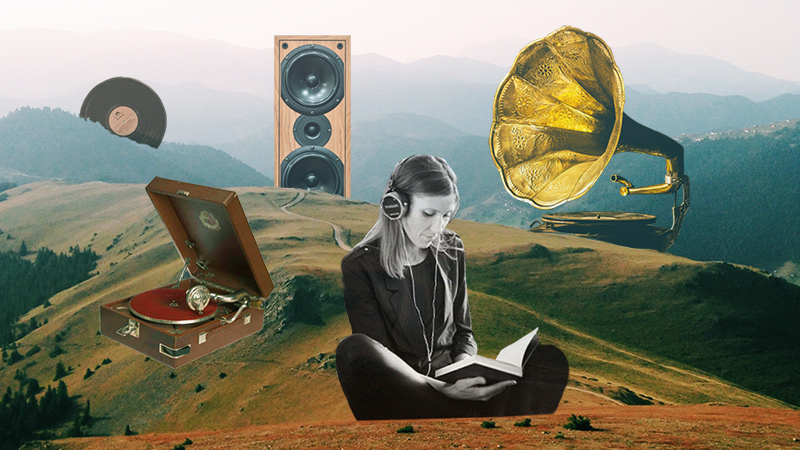In the early ‘90s, then-university student Gunther Frohnhöfer worked at an audio shop to pay for his studies. During his childhood, there wasn’t yet a distinction between “analog” and “digital,” but the winds of change were picking up all around him.
After graduation, he realized he didn’t resonate with his degree, broadcast engineering, but with engineering basics, he delved deeper into the audio world. At this point, CDs were quickly overshadowing tapes and vinyl. Microchips were replacing vacuum tubes. Pocket-size was seen as the new luxury, in contrast to analog setups that ate up half a room. The only vinyl records in the market now were secondhand. New pressings were seen as sunk costs.
Nonetheless, armed with faith in his knowledge and an intuition in the “market’s momentum going up” he decided in 1995 to start Acoustic Signature, a high-end, high-fidelity turntable manufacturer.
With ironic humor atypically German, Frohnhöfer says his gambit was “stupid, you can call it that.” I insist on calling it “brave.”
“Brave, stupid, both.”
It’s a miracle the company survived to reach the recent resurgence of vinyl, which no one then really predicted.
Today, Acoustic Signature is known for quality turntables. All processes are done in-house in its Stuttgart plant, a city known as Mercedes-Benz’s hometown. The company only employs highly-skilled laborers: watchmakers, jewelers and goldsmiths. The Asian market, Frohnhöfer describes, keeps the company afloat, with 85 percent of its revenue coming from exports to the region.
Here, hi-fi audio expos are regularly held in Tokyo, Singapore and Guangzhou and are known as meccas for audiophiles. Acoustic Signature is recently opening in Manila, and Frohnhöfer is pleasantly surprised at the ardent community here.
High fidelity

Every year, since 2008, Dusit Thani Makati has played host to arguably the largest of the Philippines’ analog audio fairs: The November Hi-Fi Show. As 2020 marches in earnest, the people behind the show will begin preparing again—sources reveal that it takes up to six months to prepare for each one-weekend expo.
The major conference rooms in the second floor as well as the suites in an entire floor are transformed into mini-theaters showcasing both bespoke and mass-produced analog audio products: Sony showcases side-by-side with Davaoeno hobbyists, for one.
The resurgence of analog audio has become part of our everyday consciousness. Aside from the November Hi-Fi show, there’s also the Satchmi Vinyl Day, and similar expos popping up around the metro. There was a noticeable spike in interest in the last decade tied to hipster nostalgia, but gimmicks come and go while classics are such for a reason.
Hi-fi, or high-fidelity, is not necessarily high-end. Tonyboy de Leon, the man behind the November show notes that names known for high-end appliances don’t necessarily produce high-fidelity audio products. Hi-fi refers to the quality and techniques going into each part of an audio setup, from wirings and needles to speakers. And these, much like the application of terroir, aging and special wood casks among vintners, translate to the “taste” of sound, so to speak.
As such, a high-end electronics brand may not necessarily invest in procedures or materials that make for high-fidelity sounds. High-fidelity audio then is not just a science but an art.
Today, the hi-fi audio market is similar to that of other top-shelf collectibles like watches, classic cars and fine art.
Philippine ear lines
For some foreigners, it’s the Filipino approach to music that fosters a discerning audiophile community.
2019 was Shinichi Suzuki’s second year at the November Hi-Fi Show. Touted as a rockstar for his speaker systems in the high-end audio world, de Leon was initially surprised at Suzuki’s willingness to participate. In person, despite his white hair, he smiles easily, conspiratorially, with the innocence of a boy who just discovered how to build catapults from scrap wood.
One of his favorite Filipino artists is an opera singer based in Taiwan. Last year’s showroom was in collaboration with Harana, a bespoke speaker maker based in QC. Suzuki isn’t very fluent in English, so one of his employees, Filipina Rosalie B. Esguerra interprets for us.
His showroom is quite different from the rest, at least in floor plan. Where others have a square plan with rows and columns of monobloc chairs facing the audio setup, Suzuki’s looks more like an inverted spatula. The first four “rows” consist of single chairs. The last rows have no more than three chairs each.
Where other rooms simply want to house as many listeners, Shinichi wants each of his visitors to immerse in the nuances of his creations.
True enough, sitting at the very front is different from sitting at the fourth row: at the former, voices and trebles are highlighted, at the latter, all the instruments, highs and lows, seem to come at you simultaneously. Suzuki tells me the second row is optimal.
Thinking out loud, he notes that Filipinos are not only discerning of technical details: price points, output-per-watt, and setup-order but also enjoy music viscerally. We take to a song’s warmth, brightness and layering like oxygen.
Claire Jiang, country manager of Jaben Pte. Ltd., a Singaporean company sourcing well-made customizable earphones, shares similar sentiments. She notes how, in contrast to her home culture, Philippine culture is “very music-driven, very singing-driven.”
One of the last-minute presenters, she plans to invite a Filipino company based in Cavite—in a booth next to theirs—to distribute their products through her company. Jaben sells customizable earphones from different brands, and their main focus is “to bring in high-quality manufacturers.”
The sound of music

The November Hi-Fi show is both a passion project and business opportunity, but the weights are distributed across different participants. For many of the newer presenters, be it a long-time company like Acoustic Signature or a startup from outside Manila, this is an much-anticipated opportunity to reach a wider market. For some, like de Leon, who has a day job running a repair company, and Victor Sierra, a Cebuano school manager and analog speaker builder by night (more accurately, on weekends), the show is a playground.
It’s a visceral experience for de Leon, whose recollections of vinyl tie intimately with his childhood memories. Back then, it was a bonding experience for the barkada: when a friend purchased a new record, others would be invited over and the whole gang would listen to each track, flipping through the album art and lyric sheets.
Bonding over raw music and its tangible products, with no other distractions: It’s that purity that de Leon aims to cultivate and revive.
The main audience of such shows are mostly middle-aged, high-income people, but of late, younger folks have been showing up. It seems analog audio was buoyed to survival by the nostalgia of older generations, brought into vogue by the nostalgia of twentysomethings who didn’t even live through the eras longed for and is kept steadily afloat by the fact that analog audio has advantages digital audio doesn’t have.
It seems that in creating technology that’s more convenient, certain advantages were lost, as people are today slowly beginning to realize.
That intuitive ear
Analog audio is part of a greater cross-cultural movement, likely the result of a fast-paced world, where making things speedier, more compact or more convenient isn’t necessarily better. Quality, enjoyment and even community are the prices we pay for perceived benefits. It’s not just in audio but also in fields like cooking (slow food) and wellness (mindfulness).
The Philippines is indeed a market for analog audio, part of a global market influenced by regional differences in labor and raw material, but a local market built on culture. And ours is a culture that breathes music, whose understanding of technology starts with an experience of music.
From the earliest memories of indigenous rituals and fiestas—all communal events—to recent memories of vinyl and analog’s heyday side-by-side with the birth of Manila Sound and OPM, music is the driving force behind our ability to understand the techniques of sound.
There’s still a lot to learn, both technically and culturally, as Filipinos are recently discovering the accessibility of forms like opera and philharmonic ensembles. But that intuitive ear remains.
Indeed, ours is not just a market but a community.
Get more stories like this by subscribing to our weekly newsletter here.
Read more:
This 15-seater bar has over 9,000 vinyl records
LIST: Where to shop for rotary phones, turntables, and other vintage items
How disinformation is a major symptom of a sick democracy
Writer: PAOLO VERGARA
ART CLARISSE ALFONSO




